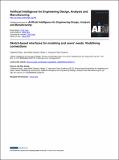| dc.contributor.author | Elsen, Catherine | |
| dc.contributor.author | Leclercq, Pierre | |
| dc.contributor.author | Yang, Maria | |
| dc.contributor.author | Demaret, Jean-Noel | |
| dc.date.accessioned | 2013-07-26T16:16:29Z | |
| dc.date.available | 2013-07-26T16:16:29Z | |
| dc.date.issued | 2012-08 | |
| dc.date.submitted | 2011-06 | |
| dc.identifier.issn | 0890-0604 | |
| dc.identifier.issn | 1469-1760 | |
| dc.identifier.uri | http://hdl.handle.net/1721.1/79708 | |
| dc.description.abstract | The goal of this paper is to reexamine assumptions about sketch-based interfaces for modeling in the context of designers' needs and practices. Research questions examine (a) the type of sketch support and (b) the timing of support. Both concepts try to determine when, what, why and how to augment design processes in a way that is useful to designers. Two experiments (one in architecture and one in product design) based on ergonomics theory are conducted and intend to question some of these assumptions. The Port Zeeland experiment examines how 20 novices perceive and copy a blurred architectural sketch, which provides clues for a sketch interpretation system. The “Tragere” experiment studies how 12 professional product designers, some of whom are “idea generators” and others “idea pursuers,” perceive, recognize, and handle a design sketch. The results take a designer's point of view in assessing the timing and value of sketch assistance in product design. The quantitative data analysis provides rich clues about when, why and how product sketches should be supported. The paper explores the strategies developed by designers to perceive and recognize graphical content and discusses the generation of three-dimensional volumes, the univocity state between sketches and three-dimensional models, and the treatment of features in freehand sketches. The paper concludes with observations on the timing and value of support, as first integrated in NEMo, a tool for early stage architectural design, and then in PEPS[superscript 3], an early stage framework for product design. | en_US |
| dc.language.iso | en_US | |
| dc.publisher | Cambridge University Press | en_US |
| dc.relation.isversionof | http://dx.doi.org/10.1017/S0890060412000157 | en_US |
| dc.rights | Article is made available in accordance with the publisher's policy and may be subject to US copyright law. Please refer to the publisher's site for terms of use. | en_US |
| dc.source | MIT web domain | en_US |
| dc.title | Sketch-based interfaces for modeling and users' needs: Redefining connections | en_US |
| dc.type | Article | en_US |
| dc.identifier.citation | Elsen, Catherine, Jean-Noël Demaret, Maria C. Yang, and Pierre Leclercq. Sketch-based Interfaces for Modeling and Users Needs: Redefining Connections. Artificial Intelligence for Engineering Design, Analysis and Manufacturing 26, no. 03 (August 14, 2012): 281-301. © Cambridge University Press 2012 | en_US |
| dc.contributor.department | Massachusetts Institute of Technology. Department of Mechanical Engineering | en_US |
| dc.contributor.department | Massachusetts Institute of Technology. Engineering Systems Division | en_US |
| dc.contributor.mitauthor | Elsen, Catherine | en_US |
| dc.contributor.mitauthor | Yang, Maria | en_US |
| dc.relation.journal | Artificial Intelligence for Engineering Design, Analysis and Manufacturing | en_US |
| dc.eprint.version | Final published version | en_US |
| dc.type.uri | http://purl.org/eprint/type/JournalArticle | en_US |
| eprint.status | http://purl.org/eprint/status/PeerReviewed | en_US |
| dspace.orderedauthors | Elsen, Catherine; Demaret, Jean-Noël; Yang, Maria C.; Leclercq, Pierre | en_US |
| dc.identifier.orcid | https://orcid.org/0000-0002-7776-3423 | |
| dc.identifier.orcid | https://orcid.org/0000-0002-2434-0451 | |
| mit.license | PUBLISHER_POLICY | en_US |
| mit.metadata.status | Complete | |
